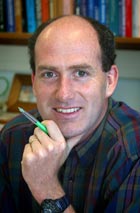Richard Hartshorne
From Geography
Richard Hartshorne (1899 - 1992) was a prominent American geographer, who became very well known in the debate about the nature of a subject in de late fifties. Especially his book The nature of Geography (1939) was responsible for his high rank at the the list of influent people out of the geography field.Geography, like history, is according to i.e. Hartshorne, essential to the full understanding of reality. The naked, schematic study of the systematic sciences divides up reality into academic compartments, and thereby necessarily destroys something of its essential character:
"Ach, von ihrem lebenwarmen Bilde Blieb der Schatten nur zurück."
Geography adds, as Paul Vidal de la Blache said, "the aptitude of comprehending the correspondence and correlation of facts, be they in the terrestrial milieu which includes them all, be they in the regional milieu in which they are localized (Hartshorne, 1939, p. 183.)
In his book "The nature of Geography" (1939) Hartshorne tells us the following: Systematic geography is organized in terms of particular phenomena of general geographic significance, each of which is studied in terms of the relations of its areal differentiation to that of the others. Its descriptive form is therefore similar to that of the systematic sciences. Like them, it seeks to establish generic concepts of the phenomena studied and universal principles of their relationships, but only in terms of significance to areal differentiation. No more than in the systematic sciences, however, can systematic geography hope to express all its knowledge in terms of universals; much must be expressed and studied as unique.
Particularly his ideas about regional geography/regionalisation are important and interesting. The regional geography can be divided in compositional regional geography and a contextual regional geography. Regional geography organizes the knowledge of all interrelated forms of areal differentiation in individual units of area, which it must organize into a system of division and subdivision of the total earth surface. Its form of description involves two steps. It must first express, by analysis and synthesis, the integration of all interrelated features at individual unit places, and must then express, by analysis and synthesis, the integration of all such unit places within a given area. In order to make this possible, it must distort reality to the extent of considering small but finite areas as homogeneous units which can be compared with each other and added together in areal patterns of larger units. These larger, likewise arbitrary units, are so determined as to make possible a minimum of generalized description of each unit "region," that will involve a minimum of inaccuracy and incompleteness (Hartshorne, 1939, p. 211).
Hartshorne and space
In his influential book “The nature of geography (1939)”, Richard Hartshorne took a ‘strange’ position in the history of geography. He saw geography as a discipline concerned with the organization of phenomena in space, but didn’t provide a concept of his vision on space itself. Hartshorne took it for granted that space was like time: a universal of human existence, an external coordinate, an empty grid of mutually exclusive points, an ‘unchanging box within which objects exist and events occur (Gregory, D, 2009, p. 708).
As a ‘Kantian’, he saw geography and history only different in the consideration of time and [space] (Gregory, D, 2009, p. 399):
“Geography and history are alike in that they are integrating sciences concerned with studying the world. There is, therefore, a universal and mutual relation between them, even though their bases of integration are in a sense opposite – geography in terms of earth spaces, history in terms of periods of time.” (Hartshorne, 1939)
His concept of absolute space would develop to a concept of relative space 'between objects and events'. Nevertheless, many of Hartshorne's postwar critics agreed that 'spatial relations are the ones that matter in geography and no others'. (Grogeroy, D, 2009, p. 708)
Nowadays his work is still influent in several geography studies and uses as a basic principle by several geographers from all over the world.
Reference:
Gregory, D., Johnston, R., Pratt, G., Watts, M. & Whatmore, S. (2009). The dictionary of human geography. Wiley-Blackwell. Hartshorne, R. (1939). The nature of Geography. Assocation of American geographers, Lancaster, Penn.
Published by Luuk Robers & Paul Leemans
Added by Josse Groen
Links added --62.194.210.153 20:29, 20 October 2011 (CEST)
image added by JoepGobbens 11:14, 21 October 2012
